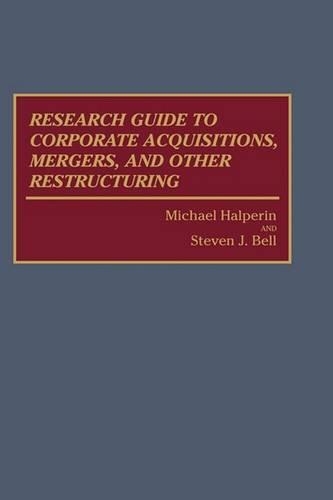
Research Guide to Corporate Acquisitions, Mergers, and Other Restructuring
(Hardback)
Publishing Details
Research Guide to Corporate Acquisitions, Mergers, and Other Restructuring
By (Author) Steven J. Bell
By (author) Michael Halperin
Bloomsbury Publishing PLC
Greenwood Press
30th May 1992
United States
Classifications
Tertiary Education
Non Fiction
Reference works
658.1
Physical Properties
Hardback
232
Width 156mm, Height 235mm
510g
Description
This is a sourcebook for collecting information required for corporate merger and acquisition research. A particular strength of the "guide" is its focus on time-sharing online databanks for information retrieval. Readers can learn which databanks can be used for M&A research, and search examples and techniques are described. The authors use their research expertise to identify appropriate strategies, provide database tips and techniques, and point out unique features of the many M&A research tools discussed. This guide is a tool for all users of corporate change information that include economists, accountants, attorneys, financial analysts and officers, managers, academics, and students of business.
Reviews
Business librarians should examine this guide carefully, since it has much to offer on a popular topic. Although the popularity of mergers and acquisitions has subsided in the 1990s as compared to the 1980s, they still occur, as does the restructuring of many companies due to bankruptcy and other debt problems. The compilers, librarians from the Wharton School of Business, write from a business, not a legal standpoint. Online sources are stressed more than conventional print media. Since the authors believe online databases offer greater speed of information for M & A activity, they describe these sources and give examples of what each has to offer. This technique makes it easier for novices to understand and acts as a quick review for experienced database searchers. Arranged by chapters, the book also contains two appendixes charting the giving addresses of the databases discussed and a glossary of terms. The binding and typography are exemplary. Highly recommended for business libraries.-Choice
Knowing which source to use to find specific information is now easier because of this excellent guide. Academic and public libraries answering questions about corporate acquisitions and mergers should purchase this book.-Reference Books Bulletin
"Business librarians should examine this guide carefully, since it has much to offer on a popular topic. Although the popularity of mergers and acquisitions has subsided in the 1990s as compared to the 1980s, they still occur, as does the restructuring of many companies due to bankruptcy and other debt problems. The compilers, librarians from the Wharton School of Business, write from a business, not a legal standpoint. Online sources are stressed more than conventional print media. Since the authors believe online databases offer greater speed of information for M & A activity, they describe these sources and give examples of what each has to offer. This technique makes it easier for novices to understand and acts as a quick review for experienced database searchers. Arranged by chapters, the book also contains two appendixes charting the giving addresses of the databases discussed and a glossary of terms. The binding and typography are exemplary. Highly recommended for business libraries."-Choice
"Knowing which source to use to find specific information is now easier because of this excellent guide. Academic and public libraries answering questions about corporate acquisitions and mergers should purchase this book."-Reference Books Bulletin
Author Bio
MICHAEL HALPERIN is Librarian, Lippincott Library of the Wharton School, University of Pennsylvania, and Adjunct Professor at Drexel University's College of Information Studies. In addition to information resources for M & A research, his research interests include machine readable resources for business, and the publications of industrial scientists. STEVEN J. BELL is Head of Circulation Services and Reference Librarian at the Lippincott Library of the Wharton School, University of Pennsylvania. His research interests include information resources for M & A, telecommunications software, end-users of online databanks and the journals Online, Database, Link-Up, Special Libraries, and Education for Information.
